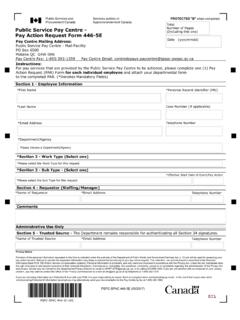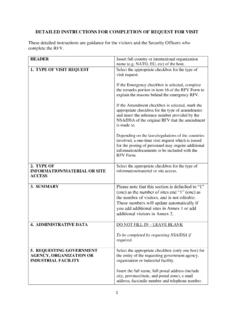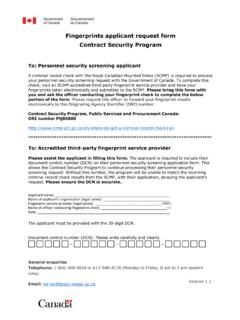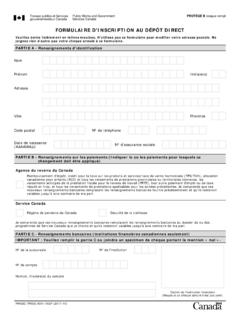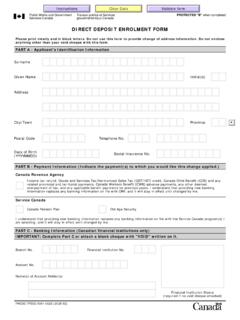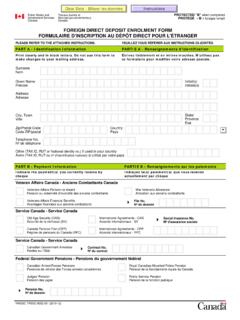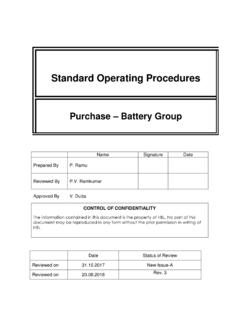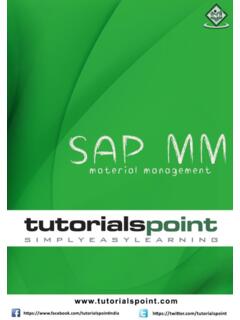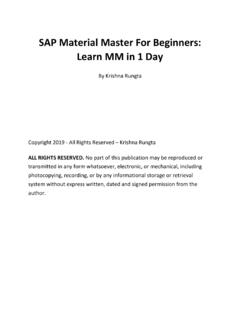Transcription of Procurement Knowledge Exam — Level I
1 Preparation Guide Procurement Knowledge Exam Level I. Information and Sample Test Questions Overview The Procurement Knowledge Exam Level I is used to assess federal employees who are seeking to become Certified Federal Procurement Specialists (CFSP) under the Treasury Board of Canada Secretariat's Professional Development and Certification Program. Candidates are eligible to take the exam once their application for certification has been approved, that is, once they have successfully completed both a Record of Learning and a Candidate Achievement Record.
2 Information about the Professional Development and Certification Program and the certification process is available at the following Web addresses: The Procurement Knowledge Exam Level I assesses the Knowledge requirement of the Functional Competency Cluster of the Canadian General Standards Board standard, Competencies of the Federal Government Procurement , Materiel Management and Real Property Community. The exam contains a total of 101 multiple-choice questions on the four phases of life cycle asset management: Phase One: Assessment and Planning Phase Two: Acquisition Phase Three: Operations, Use and Maintenance Phase Four: Disposal The majority of the questions (80%) cover Phases 1 and 2 while the remaining questions (20%) cover Phases 3 and 4.
3 Examination questions were written and reviewed by your peers under the guidance of the Personnel Psychology Centre of the Public Service Commission. After an extensive pilot examination process was conducted across the country, the exam questions and format were reviewed and approved by the Continuous Learning Working Group and the Professional Development Advisory Committee. For each question, you will select your answer from among five answer choices. You will indicate your choice by making a pencil mark that completely fills the circle corresponding to your choice in the answer sheet.
4 You will darken ONLY ONE circle for each question. Any other way of answering will be scored as incorrect. If you wish to change an answer, you must erase your first mark completely and then record your new choice. Your score will correspond to the total number of correct answers. You are advised to try to answer all of the questions, and not to spend too much time on a difficult question. You should guess when you are not sure of an answer, as no points are deducted for incorrect answers. To increase your chances of choosing the correct answer, eliminate the choices that you know are wrong before guessing.
5 You will have two hours and thirty minutes to complete the exam. Including administrative time, a test session will take approximately three hours. 1. Study Tips 1. Review the Knowledge requirements for all of the Level I Procurement competencies, listed in Appendix A of , Competencies of the Federal Government Procurement , Materiel Management and Real Property Community, available at the following Web address: 2. Review the course training materials and desktop reference tools provided as part of your training.
6 A. comprehensive list of the training requirements is available at the following Web address: 3. Try the sample questions on page 3. Although these questions are not necessarily of the same difficulty as the questions in the actual exam, they should give you an idea of what to expect. Strategies for Exam Success 1. Maintain a positive attitude (confidence). The certification exam is a way to demonstrate your Knowledge while obtaining professional recognition. You have met the eligibility requirements ( education and experience), and now is the opportunity to demonstrate your Knowledge .
7 2. Get a good night's sleep and eat a nourishing breakfast. (Your brain needs rest and nutrients to perform optimally.). 3. Arrive early to become comfortable in the exam room. 4. Immediately identify to the proctor any inappropriate conditions in the room. 5. At the beginning of the session, quickly scan the exam. 6. Compartmentalize the questions into manageable blocks of time. 7. Read all the procedural directions and exam questions carefully. 8. Answer the easier questions first. 9. Do not spend too much time on a difficult question.
8 10. Identify questions that you are unsure about and return to them later. 11. Eliminate any incorrect answer choices that you know are wrong. Additional Information If you have a disability that could impede your test performance, be sure to notify the test administrators well in advance of being tested to ensure that you are provided the necessary accommodations. Bring your photo ID card and your Personal Record Identifier (PRI). Arrive at least 15 minutes before the start of the exam. You will not be allowed into the room after the test has begun.
9 Budget your time. Be sure to pace yourself so that you can finish the exam. If you finish early, review your answers. Pass the exam by correctly answering 75 out of 101 questions. If you fail the exam, take the retest. If you do not pass the test, you will be able to try the exam again 2. once the required waiting period has elapsed. The letter advising you of your results will inform you of the conditions that apply. Detailed information about retesting can be found in the following: Certification Program Handbook - Level I, available at.
10 Certification Application and Maintenance Handbook, available at;. Do not ask to see your examination paper. Examination papers will not be returned to candidates following marking, nor are they made available to candidates for review following the marking process. Sample Test Questions 1. Which of the following programs is considered a set aside? 1) Federal Contractors Program for Employment Equity 2) Procurement Strategy for Aboriginal Business 3) Comprehensive Land Claims Agreement 4) Canadian Content 5) Green Procurement 2.
